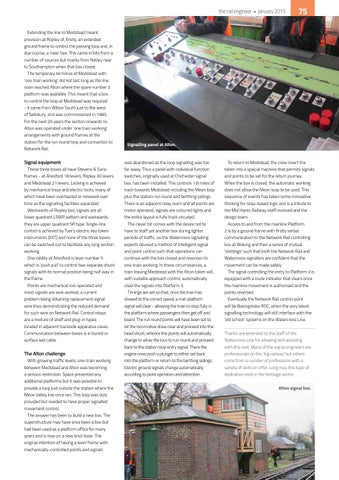the rail engineer • January 2015
Extending the line to Medstead meant provision at Ropley of, firstly, an extended ground frame to control the passing loop and, in due course, a ‘new’ box. This came in bits from a number of sources but mainly from Netley near to Southampton when that box closed. The temporary terminus at Medstead with ‘one train working’ did not last long as the line soon reached Alton where the spare number 3 platform was available. This meant that a box to control the loop at Medstead was required - it came from Wilton South just to the west of Salisbury, and was commissioned in 1985. For the next 25 years the section onwards to Alton was operated under ‘one train working’ arrangements with ground frames at the station for the run round loop and connection to Network Rail.
Signal equipment These three boxes all have Stevens & Sons frames - at Alresford 18 levers, Ropley 30 levers and Medstead 21 levers. Locking is achieved by mechanical trays and electric locks, many of which have been overhauled or renewed over time as the signalling facilities expanded. Westwards of Ropley box, signals are all lower quadrant LSWR pattern and eastwards, they are upper quadrant SR type. Single-line control is achieved by Tyer’s electric key token instruments (EKT) and none of the three boxes can be switched out to facilitate any long section working. One oddity at Alresford is lever number 5 which is ‘push pull’ to control two separate shunt signals with its normal position being half way in the frame. Points are mechanical rod-operated and most signals are wire worked, a current problem being obtaining replacement signal wire thus demonstrating the reduced demand for such wire on Network Rail. Control relays are a mixture of shelf and plug-in types located in adjacent trackside apparatus cases. Communication between boxes is in buried or surface laid cable.
The Alton challenge With growing traffic levels, one-train working between Medstead and Alton was becoming a serious restriction. Space prevented any additional platforms but it was possible to provide a loop just outside the station where the Meon Valley line once ran. This loop was duly provided but needed to have proper signalled movement control. The answer has been to build a new box. The superstructure may have once been a box but had been used as a platform office for many years and is now on a new brick base. The original intention of having a lever frame with mechanically-controlled points and signals
75
Signalling panel at Alton. was abandoned as the loop signalling was too far away. Thus a panel with individual function switches, originally used at Chichester signal box, has been installed. This controls 1.8 miles of track towards Medstead including the Meon loop plus the station run round and berthing sidings. There is an adjacent relay room and all points are motor operated, signals are coloured lights and the entire layout is fully track circuited. The clever bit comes with the desire not to have to staff yet another box during lighter periods of traffic, so the Watercress signalling experts devised a method of intelligent signal and point control such that operations can continue with the box closed and reversion to one-train working. In these circumstances, a train leaving Medstead with the Alton token will, with suitable approach control, automatically clear the signals into Platform 3. Timings are set so that, once the train has slowed to the correct speed, a mid-platform signal will clear - allowing the train to stop fully in the platform where passengers then get off and board. The run round points will have been set to let the locomotive draw clear and proceed into the head shunt, whence the points will automatically change to allow the loco to run round and proceed back to the station loop entry signal. There the engine crew push a plunger to either set back into the platform or return to the berthing sidings. Electric ground signals change automatically according to point operation and detection.
To return to Medstead, the crew insert the token into a special machine that permits signals and points to be set for the return journey. When the box is closed, the automatic working does not allow the Meon loop to be used. This sequence of events has taken some innovative thinking for relay-based logic and is a tribute to the Mid Hants Railway staff involved and the design team. Access to and from the mainline Platform 2 is by a ground frame with firstly verbal communication to the Network Rail controlling box at Woking and then a series of mutual ‘slottings’ such that both the Network Rail and Watercress signallers are confident that the movement can be made safely. The signal controlling the entry to Platform 3 is equipped with a route indicator that clears once the mainline movement is authorised and the points reversed. Eventually the Network Rail control point will be Basingstoke ROC, when the very latest signalling technology will still interface with the ‘old school’ systems on the Watercress Line. Thanks are extended to the staff of the Watercress Line for allowing and assisting with this visit. Many of the signal engineers are professionals on the ‘big railway’ but others come from a number of professions with a variety of skills on offer. Long may this type of dedication exist in the heritage sector. Alton signal box.
